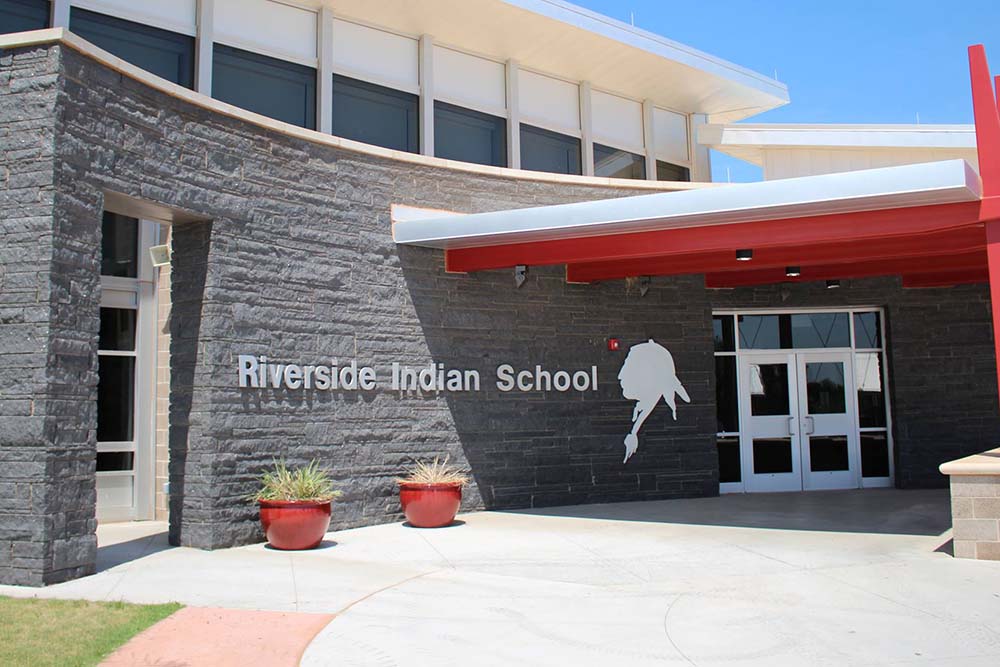
- Details
- By Levi Rickert and Neely Bardwell
OKLAHOMA CITY, Okla. — U.S. Secretary of the Interior Deb Haaland (Laguna Pueblo) and Assistant Secretary of the Interior for Indian Affairs Bryan Newland (Bay Mills Indian Community) will visit the Riverside Indian School in Anadarko, Okla. on Saturday, July 9, 2022 at 10 a.m.
Riverside Indian School, now operated by the Bureau of Indian Education (BIE), is home to some 800 Native students. What once was a place for cultural assimilation and colonization, is now a place for Native students, who represent over 75 different U.S. tribes, to engage in culture and spirituality while receiving an education.
The Riverside Indian School is Deb Haaland’s first stop on the Department of Interior’s “Road to Healing Tour” that was announced on May 11, with the release of the Federal Indian Boarding School Initiative Investigative Report. Haaland and Newland will be conducting listening sessions to hear from the survivors of boarding schools.
Other Road to Healing Tour visits will include sites in Hawai’i, Michigan, Arizona, and South Dakota during 2022. More states will be announced for the tour for 2023.
“We appreciate Secretary Deb Haaland and the U.S. Department of the Interior for taking on this very important project. We also thank the many partners, tribal nations, individuals and families that have participated and shared their story so far. May we continue to build on this initiative so that we can learn and offer healing to those affected,” said Governor of the Chickasaw Nation based in Ada, Oklahoma, Bill Anoatubby in a Facebook Post.
History
Riverside Indian School first opened in 1871 and is one of the oldest federally operated boarding schools in the United States. Initially, it was organized by Quaker missionaries and opened under the name Wichita-Caddo School. In 1878-1879 the school was renamed the Riverside Indian School.
The school resides on the same land the school was founded on–more than 135 acres, located on Wichita, Caddo and Delaware (WCD) land. The only thing that still remains from the original school is a graveyard that sits atop a hill. Due to lack of proper record keeping, the number of children buried there is still unclear.
There was no mention of Riverside Indian School included in Volume 1 of the Federal Boarding School Initiative Investigative Report.
Present Day
Today, the school is the oldest and largest off-reservation boarding school. They offer education for grades 4th through 12th. Five different dormitories are located on the campus, two of which opened in 2014 and 2015. Riverside Indian School houses students for nine months out of the year.
There is a large emphasis on athletics, the school’s mascot is the Braves. The school offers a chance for high school students to participate in Basketball, Baseball, Softball, Track and Cross Country.
Help us defend tribal sovereignty.
At Native News Online, our mission is rooted in telling the stories that strengthen sovereignty and uplift Indigenous voices — not just at year’s end, but every single day.
Because of your generosity last year, we were able to keep our reporters on the ground in tribal communities, at national gatherings and in the halls of Congress — covering the issues that matter most to Indian Country: sovereignty, culture, education, health and economic opportunity.
That support sustained us through a tough year in 2025. Now, as we look to the year ahead, we need your help right now to ensure warrior journalism remains strong — reporting that defends tribal sovereignty, amplifies Native truth, and holds power accountable.
 The stakes couldn't be higher. Your support keeps Native voices heard, Native stories told and Native sovereignty defended.
The stakes couldn't be higher. Your support keeps Native voices heard, Native stories told and Native sovereignty defended.
Stand with Warrior Journalism today.
Levi Rickert (Potawatomi), Editor & Publisher
